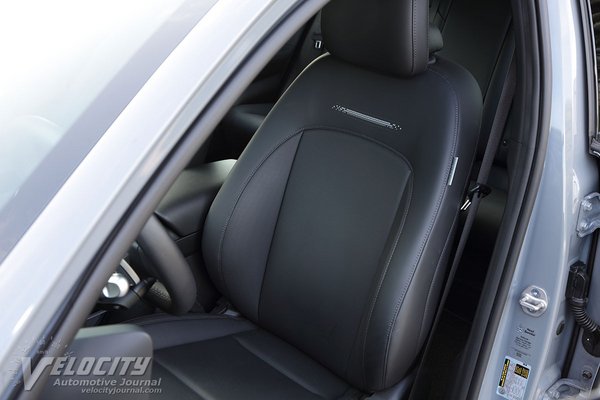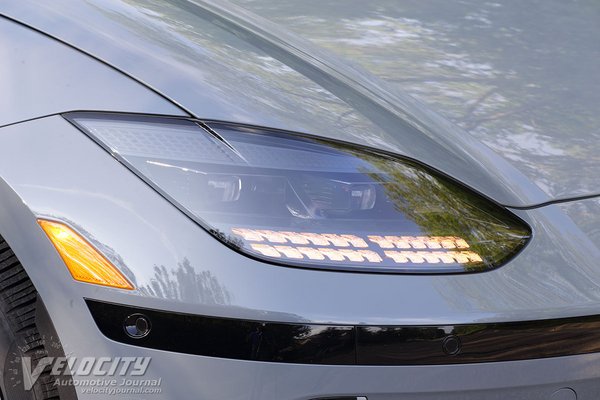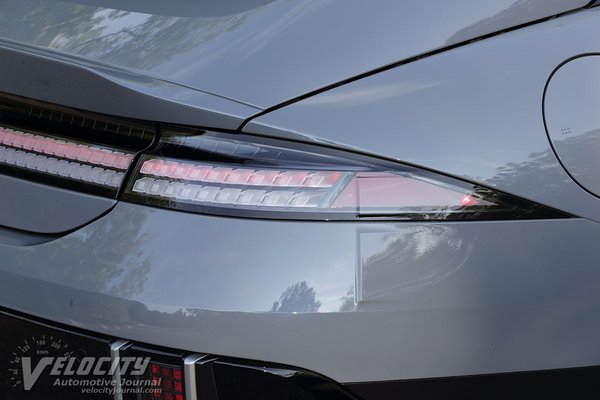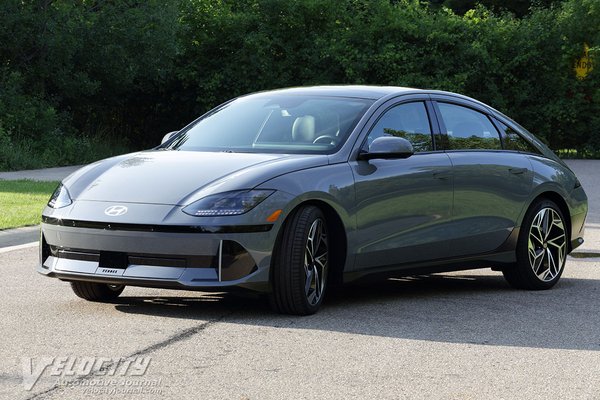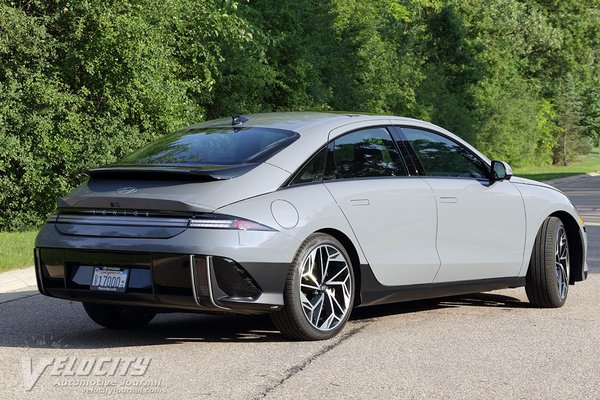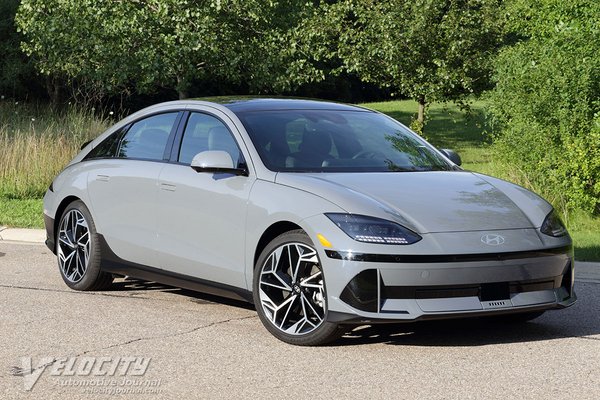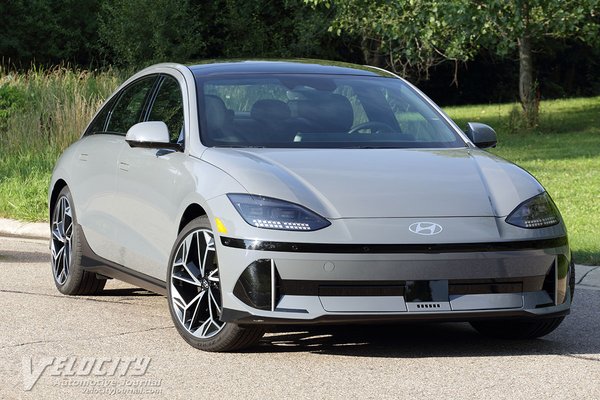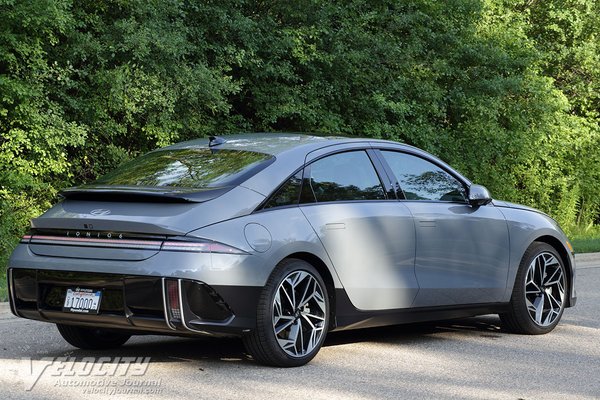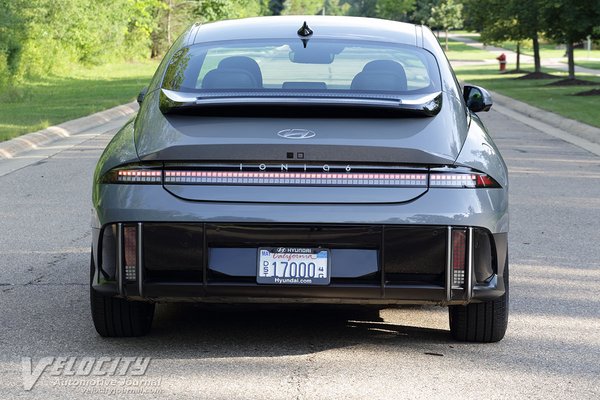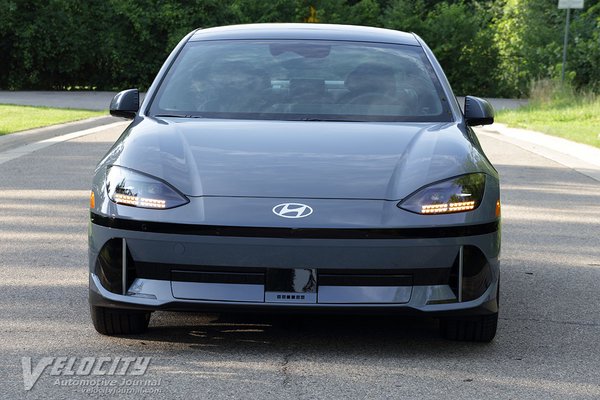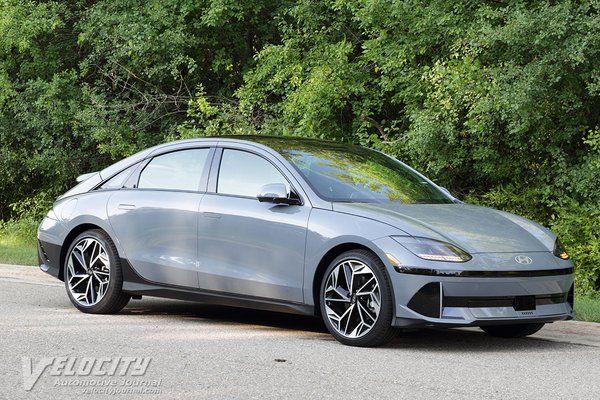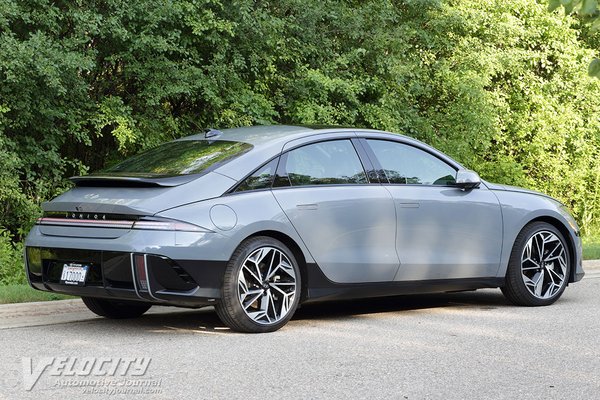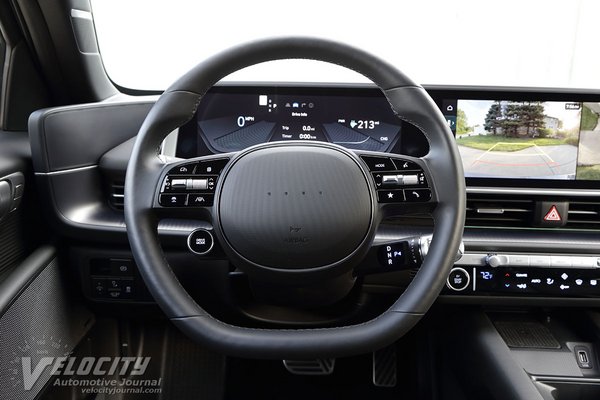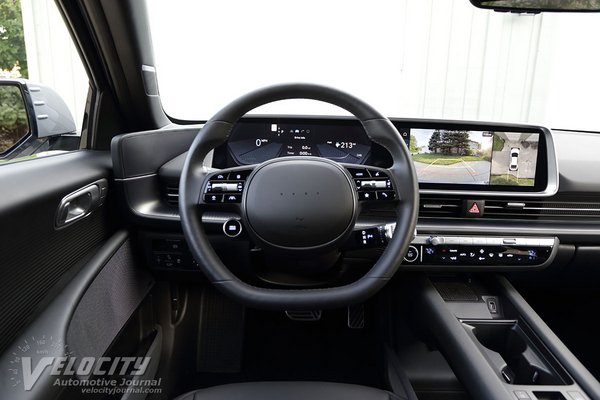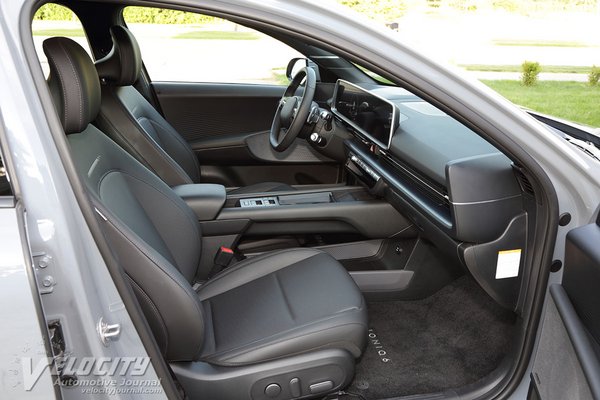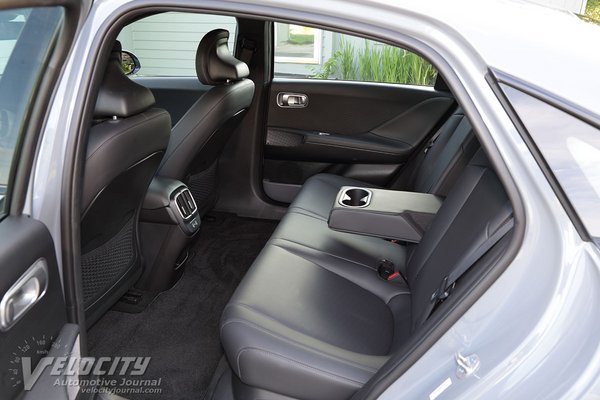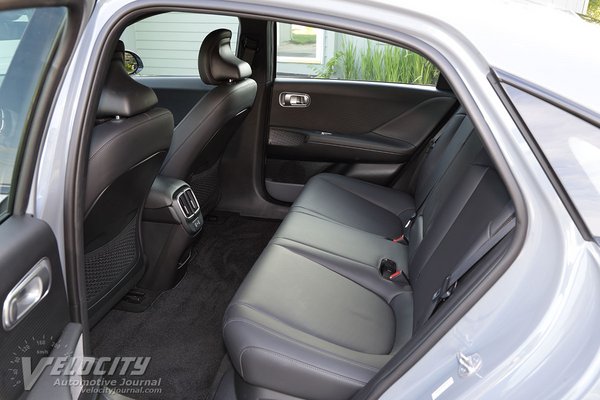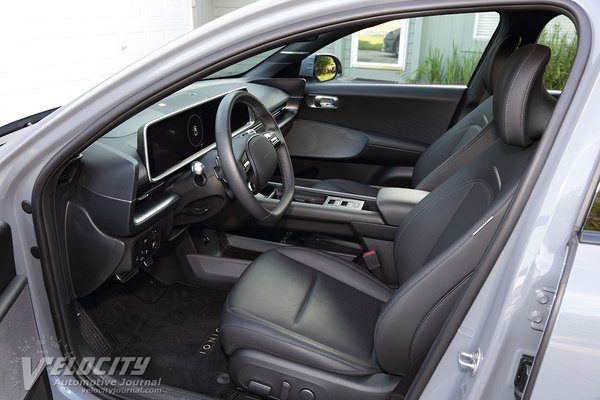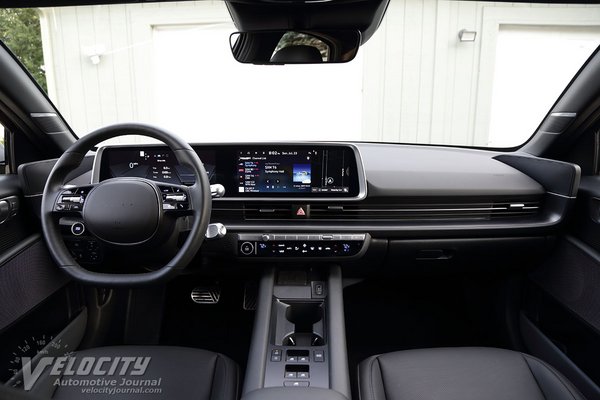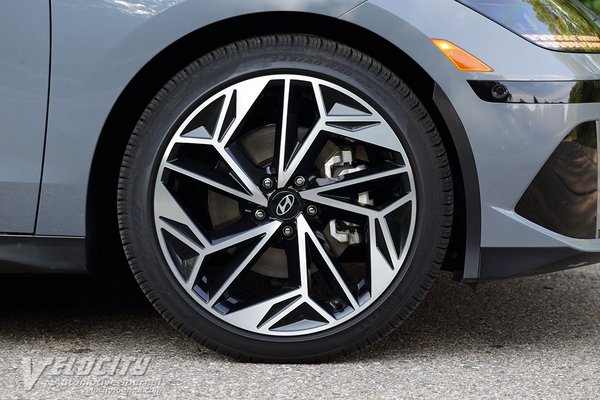2023 Hyundai Ioniq 6
11/15/2023
Shahed Hussain
Hyundai has quietly expanded its EV lineup with two Ioniq models: the midsize Ioniq 5 hatchback and Ioniq 6 sedan. Both EVs are based on the same platform, but have different styling. The Ioniq 6 is offered in four trim levels ranging from Ioniq 6 SE Standard Range ($41,600), SE ($45,500), SEL ($47,700 and the Limited ($52,600). According to Hyundai, Ioniq 6 sales are limited to certain states and dealers.
Both the SE Standard Range and SE models are RWD (rear wheel drive) only. AWD (all-wheel drive) is optional in the SEL and Limited. We tested the top Ioniq 6 Limited AWD ($56,100) which has no option. Adding the $1,115 freight fee totals up the MSRP to $57,215. Opting for the Limited RWD drops the price by $3,500. Significant standard equipment includes sunroof, rear spoiler, 8-way power driver's and passenger seat, heated and ventilated front seats, heated steering wheel, 12.3-in. infotainment display, 8-speaker Bose(R) audio system, Android Auto, and Apple CarPlay. Standard active safety technologies include: smart cruise control, forward collision-avoidance assist, lane keeping assist, lane following assist, blind-spot collision avoidance assist, surround view monitor, and blind-spot view monitor.
As the price leader, the base RWD Ioniq 6 Standard Range has a smaller 53.0 kWh/480V battery pack powering a 111 kW (149 hp)/258 lb.-ft. electric motor. Move up to the RWD Ioniq 6 and Hyundai installs a larger 77.4 kWh/697V battery pack, and uprates the motor to 168 kW (225 hp). The AWD Ioniq 6 adds a 74-kW front motor and a slightly detuned 165-kW rear motor; combined system power totals up to 239 kW (320 hp) and torque output peaks at 446 lb.-ft. Each motor connects to a single-speed gearbox (2.263:1 ratio) driving the front or rear axle through a 4.471:1 final drive ratio. A dog clutch engages and disengages the front axle on demand to reduce driveline frictional losses. Although the Ioniq's dual motors deliver impressive power and torque, Hyundai makes no 0-60 MPH claims, but top speed is limited to 115 MPH.
According to Hyundai, a Level 2 AC charger can get the 77.4 kWh battery up to 80% in 6 hr. 55 min., or the 53.0 kWh battery to the same state of charge in 5 hr. 20 min. The onboard AC charger is rated at 10.9 kW. A 50kW DC charger can replenish the 53.0 kWh battery pack to 80% in 58 min., or the 77.4 kWh battery pack to the same state of charge in 73 min. If a relatively rare 350kW DC charger is available, both batteries can charge up to 80% in an impressive 18 minutes. Our test vehicle was nearly fully charged, so we didn't need to recharge during our evaluation. According to the trip computer, we averaged between 2.2 kW/mile to 3.6 kW/mile in mixed urban and highway driving. For the 77.4 kWh battery pack, Hyundai's range estimate varies from 270-361 miles depending on the model and wheel size. Opting for the Ioniq SE RWD (18-in. wheels) yields the maximum 361-mile estimated range. The smaller 53.0 kWh battery pack in the Ioniq 6 Standard Range is rated for 240 miles. During our evaluation, the vehicle range was rated just over 300 miles, consistent with Hyundai's 316-mile range estimate for the Limited AWD. During our week evaluating the Ioniq 6 we depleted the battery to an estimated 213 miles range, not enough to require recharging. Anyone considering the Ioniq 6 should plan to invest in a Level 2 AC charger to take advantage of lower cost residential electricity rates.
The Ioniq 6 uses the typical MacPherson strut front suspension, and a multilink rear layout with dampers and coil springs. A motor-assisted rack-and-pinion steering is geared for 2.66 turns lock-to-lock. Brakes are all disc: 12.8-in. dia. rotors front and rear. The Limited gets 20-in. alloy wheels and 245/40R20 Pirelli PZero all-season tires. Curb weight ranges from 3,935 lbs. (RWD Standard Range) to 4,616 lbs. (AWD). Hyundai specifications don't explicitly note which Ioniq 6 is the heaviest version, but we suspect it's the Limited AWD model.
Hyundai's Ioniq 6 interior design is functional, bordering on spartan. Build quality is excellent, but the materials aren't especially premium. Predominantly gray interior trim is accented by gloss black and matte aluminum. The dashboard bottom curves up in an odd U-shaped edge that juts above the door panel. A flat-bottom steering wheel has integrated audio, phone and cruise controls on the spokes. The configurable LCD instrument panel displays a digital speedometer, vehicle status, and estimated range. Adjacent is the infotainment touchscreen display for navigation, audio and vehicle camera views. Both screens are seamlessly mounted in a rectangular instrument panel. Instead of a console-mounted transmission shifter, Hyundai uses a rotary knob on a steering column stalk. A wireless charging pad and USB port are located under the climate control panel. Dual cupholders are on the center console. Instead of the conventional location on the driver's door armrests, all four power window switches are on the center console. A 12V outlet is hidden under the center armrest bin. Additional storage is available beneath the center console.
The front seats are intended to fit a wide range of occupants, but the flat-bottomed cushion and small bolsters provide acceptable lateral support. Resembling neither vinyl or leather, the seat upholstery feels slightly rubbery. Front and rear headroom is acceptable for occupants up to 6 ft. tall. Rear passengers are rewarded with comfortable seats, plus ample legroom due to the nearly flat floor. A 120V/16A AC outlet is located at the bottom of the rear seats, so laptops and small home appliances can be powered by the battery pack.
As an EV, the Ioniq 6 has a different driving experience than an equivalent gasoline-powered vehicle. At low speeds, the Ioniq 6 emits an audible humming sound to prevent pedestrian collisions, a safety feature needed due to the near silence of the powertrain. The electric motors deliver power linearly, so the Ioniq 6 moves from a stop gently, or with neck-snapping acceleration depending on the accelerator position. Maximum torque is available at 0 RPM, so the dual motors allow the Ioniq 6 to pull away from traffic on urban roads. All of our driving was on dry roads, so we could not tell if the powertrain ever switched to AWD mode.
EVs use regenerative braking to recharge the battery pack. The Ioniq's steering wheel paddles adjust the level of regenerative braking to the driver's preference. We primarily used the default setting that decelerates gently like a typical gasoline-powered automatic transmission vehicle. The other regenerative settings recoup more energy, but feel more abrupt under deceleration. In normal driving, the transition from regenerative to friction braking is imperceptible in the default setting.
Hyundai doesn't intend the Ioniq 6 to be a sport sedan, so the suspension tuning is for a compliant ride, but tight damping maintains excellent body control. Around curves, the Ioniq 6 has mild body roll similar to other midsize sedans. The steering is geared fast enough for acceptable turn-in response but this Hyundai feels competent, not sporty. Tire and wind noise are subdued at highway speeds, and the Ioniq 6 tracks solidly at 80-85 MPH, so taking this EV on a road trip is an option, assuming fast chargers are available on the route.
In the midsize sedan segment, this Hyundai is among the few EVs available. Compared to the Accord and Camry hybrids, the Ioniq 6 is more expensive, even in its base SE Standard Range version. Battery material costs remain elevated, so we expect that EVs will continue to be priced higher than their hybrid competition in the near future. So if a hybrid won't meet your needs, and you must have an EV sedan, the Ioniq 6 is one of the most affordable choices on the market.



